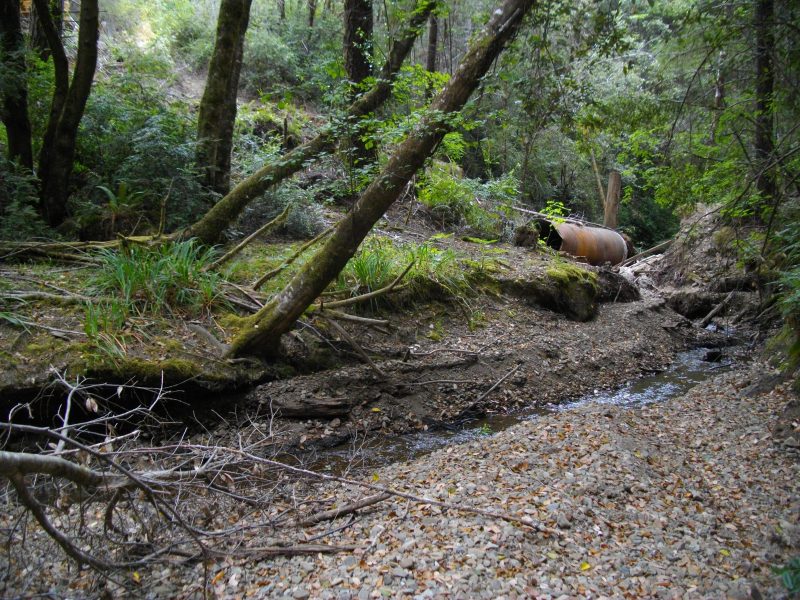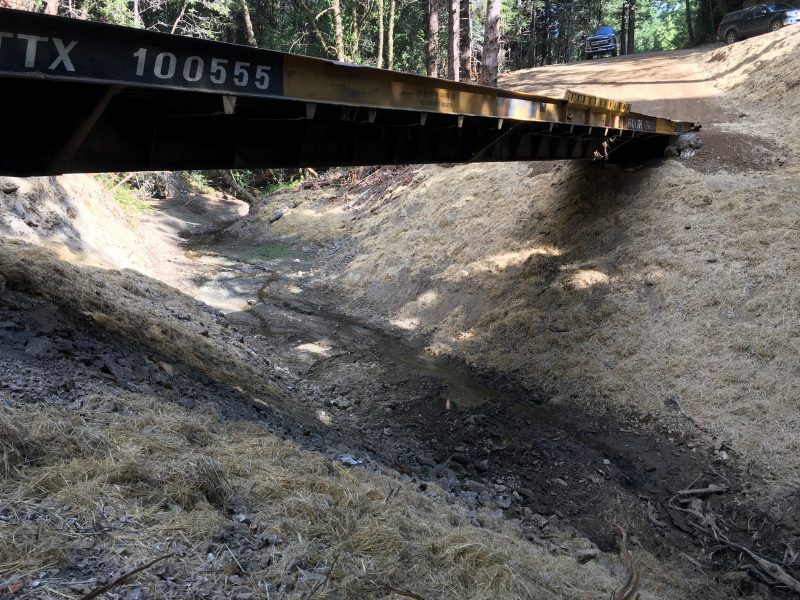Event: Restore Native Dunes 6-22-24

Remove Invasive Dune Grass to
Restore Native Dunes
- Date: 22nd June
- Time: 10am-2pm
- What to bring: Water, Sunscreen, Closed toe shoes
- Where: At the Eel River Wildlife Area, near Loleta

Event date and time: Arts Alive, Saturday April 6 from 6pm to 9pm
Location: Humboldt County Visitors Bureau, 422 1st St, Eureka
Event organizer: Humboldt Area Peoples Archive
Nicole Riggs
Executive Director
Humboldt Area Peoples Archive
707.502.4585
nriggs@manifestosynergies.com
The Humboldt Area Peoples Archive announces the grand opening of its exhibit Salmon Ceremony Oral
Histories at 6:00PM, April 6th at the Humboldt County Visitors Bureau at 422 1st St in Eureka. This
exhibit invites visitors to delve into the intricate interplay between activism, environmental
stewardship, and cultural collaboration. The evening will commence with special speeches by Nicole
Riggs, Executive Director of the Humboldt Area Peoples Archive, and Ruth Wortman, Cultural Coordinator
with the Bear River Band, promising an unforgettable experience for all attendees. This exhibit explores
the revitalization of the Salmon Ceremony by the Bear River Band at the mouth of the Mattole River in
Petrolia. The Bear River Band consists of seven federally recognized tribes: Wiyot, Nongatl, Whilkut,
Sinkiyone, Lassic, Bear River, and Mattole.
The exhibit includes the voices of Ruth Wortman and Barry Brenard, Cultural Coordinators for the
Bear River Band, speaking about the meaning of the Salmon Ceremony which existed for generations before
falling away in 1958 during the termination era. In recent decades, the Bear River Band has taken steps
to revitalize its culture.
Since 1980, the Mattole Salmon Group, a local environmental nonprofit, has been working in the river
to restore salmon habitat and populations which were negatively impacted from exploitative land
management. They realized early on that in order to bring the salmon back from the brink of extinction
for all peoples, there was a need to combine the spiritual connection of the indigenous people with
Salmon together with science-based habitat and population enhancement activities they conducted.
In 2021, a collaborative effort developed between the Bear River Band and the Mattole Salmon Group,
leading to the revitalization of the Salmon Ceremony. Every year in the fall, wild Mattole chinook and
coho salmon migrate into the river to spawn when the river breaches the sand bar, generally in November.
In April, steelhead salmon come in to spawn. At both times, juvenile salmon make their way into the
ocean to mature for several years. Both events are celebrated in the Bear River Band Salmon Ceremony.
The Humboldt Area Peoples Archive developed the interactive exhibit in collaboration with the Bear
River Band, Stacy Schaefer PhD, Ai Iwane, the Mattole Salmon Group and the Humboldt County Visitors
Bureau. The exhibit will be open to the public Tuesday to Friday 12PM-4PM until the end of June at
the Humboldt County Visitors Bureau, 422 1st St in Eureka. The Humboldt Area Peoples Archive (HAPA)
collects, preserves and makes accessible the histories of counterculture and back-to-the-land in
Humboldt and Northern California from the 1960s to now. Learn more at https://humboldtareaarchive.org/
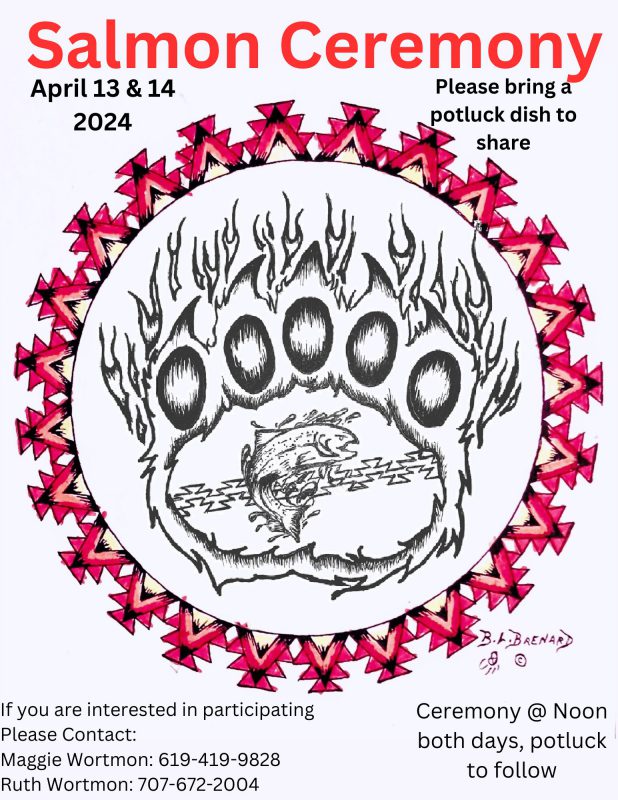

November 18 – 19, 2023
Dances start at Noon both days
Please bring a potluck dish to share!
On-site practice & dance ground setup November 17 @ 2 PM
Transportation is available for participants upon request
Barry Brenard (707) 499-3322 | Ruth Wortman (707) 672-2004
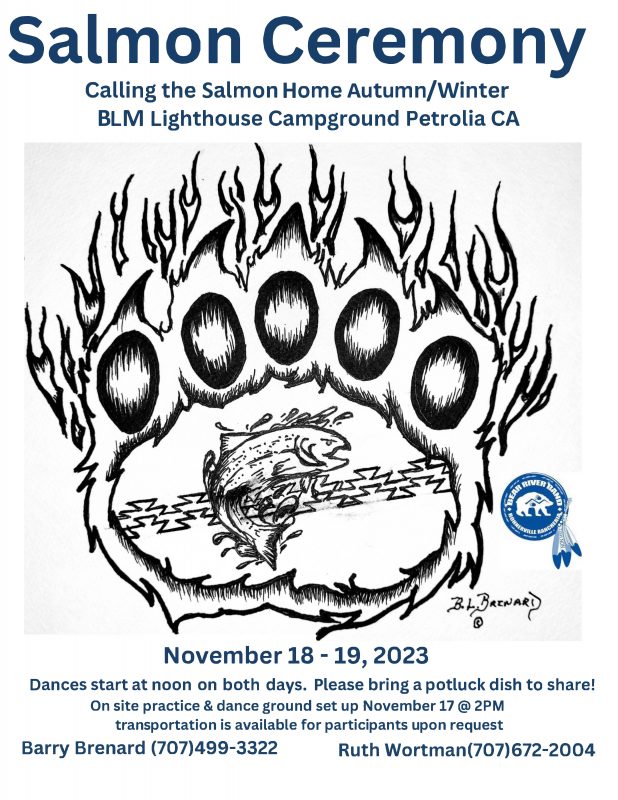
Join us for a reading from a new collection of essays from the award winning author of Totem Salmon: Life Lessons From Another Species.
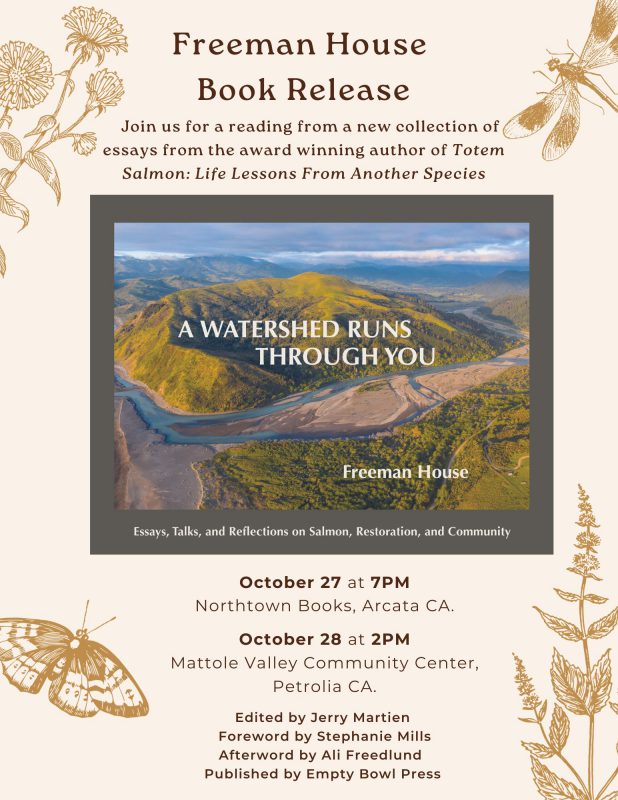
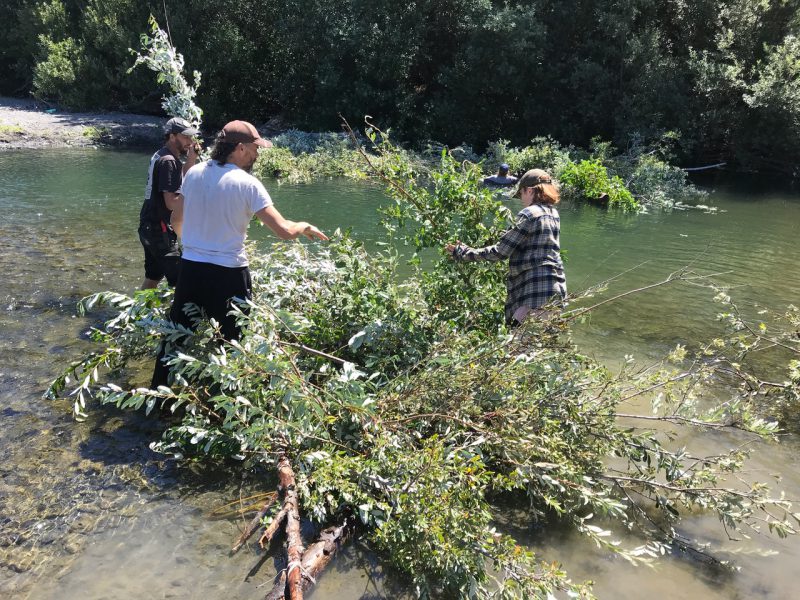
The Mattole Salmon Group and the Bear River Band are assembling driftwood and willow structures this Saturday, August 26, 2023, at 10 AM to help protect juvenile salmon hanging out at Stansberry Creek. Come join us – no special skills needed. If you have loppers bring them to cut 1” willows shoots.
For more information, call 707-eight three 4 – five 34 zero.
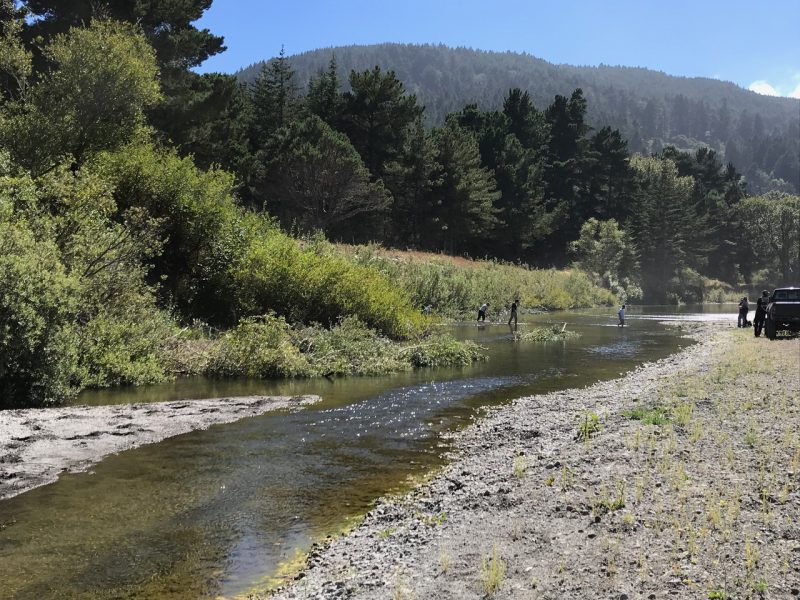
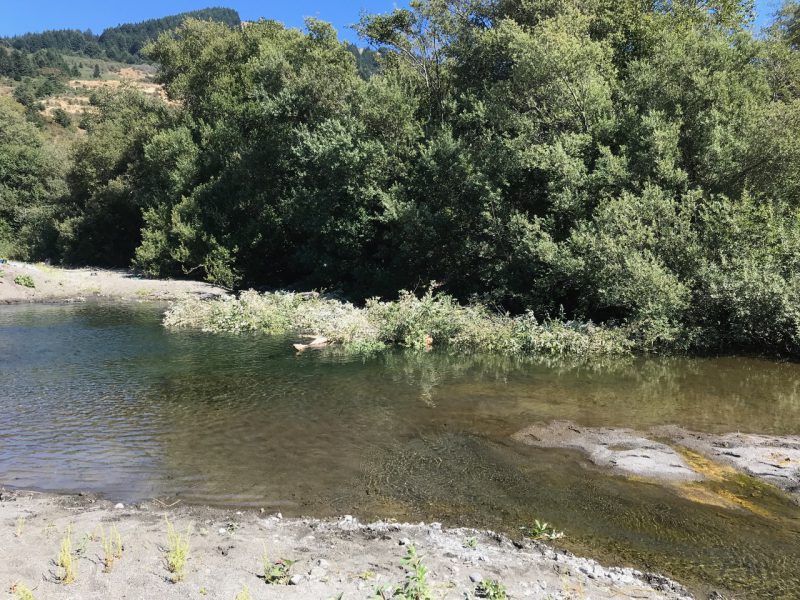
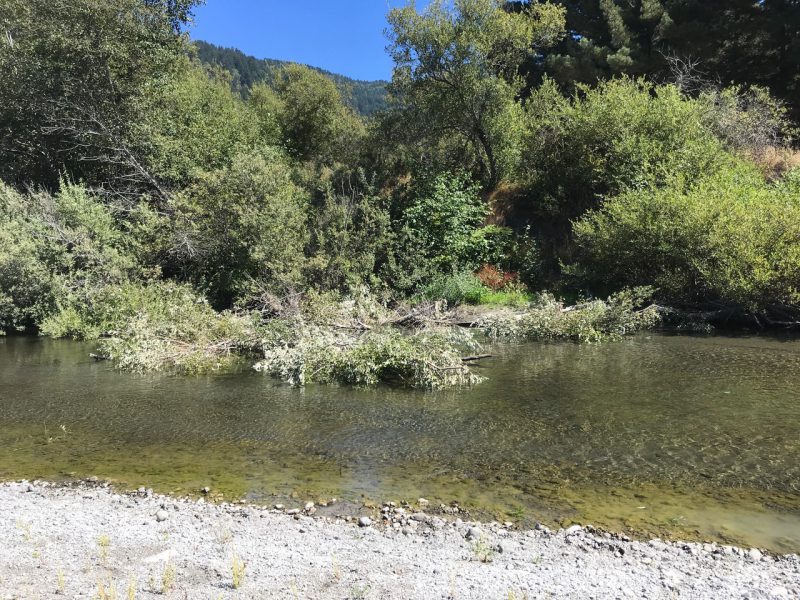
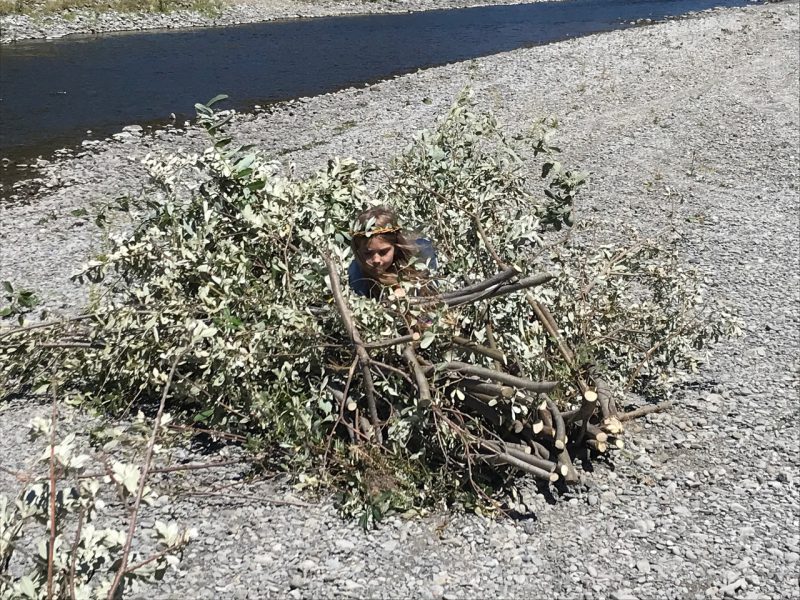

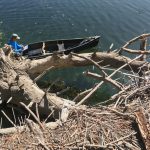
This year’s topographic survey was completed using Photogrammetry and a sUAS (aka Drone). We achieved an excellent absolute accuracy using this process along with about a dozen RTK surveyed Ground Control Points (thank you Conor Shae of the USFWS). In addition to a much more accurate survey, we also reduced costs as compared with a more traditional total station survey like we did in the past. The Estuary is ideal for drone mapping missions as the terrain is fairly flat and open. A total of nine flights at 300 feet altitude AGL (Above Ground Level).
We conduct surveys as often as possible to collect the following data:
A draft report was completed and is available for download here.
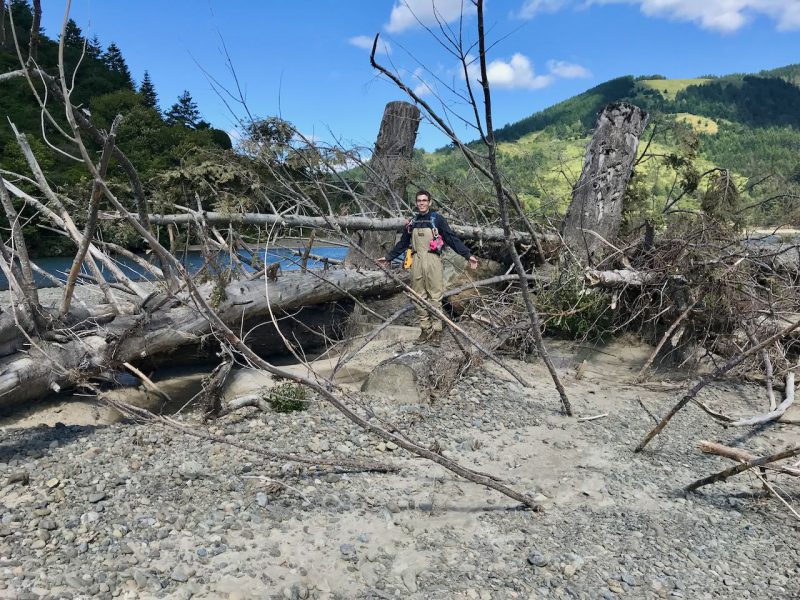
Restoration of fish habitat in the Mattole River estuary requires a comprehensive multi-year approach. The approach presented here is driven by a set of biological objectives, which, in turn, are controlled by various physical processes at work in the lower Mattole River.
The biological objectives of this effort are to:
To accomplish these objectives, this five-year strategy seeks to integrate our understanding of the dynamic nature of the lower river by identifying a suite of physical river features for treatment.
The intent of these treatments has several physical objectives:
Finally, recognizing the dynamic setting of the lower Mattole River and our ever-improving understanding of riverine processes, the proposed action is intended to be adaptive. The adaptive elements of the plan are described in detail at the end of the proposed action section.
Three specific types of projects are proposed here: placing structures on islands; installing structures at the apex of river bars; treatments along the margins of river terraces; and re-connecting a slough channel to the estuary. The specific treatment locations and types are described in detail below.
This follows monitoring work done in 2014, summer 2017, and now again in summer 2019. The 2019 survey was completed by Josh Madrone and Sungnome Madrone. A drone was used for topographic and bathymetric information combined with ground surveys of pool length, width, and depths, and locations of large wood/whole trees.
The two previous surveys were done by Total Station ground surveys, to survey features such as large wood/whole trees, stream barbs, structures, pools, and major topographic breaks. The 2014 survey was completed by Keith Barnard, Sungnome Madrone, and ________________. The 2017 survey was completed by Keith Barnard, Sungnome Madrone, Josh Madrone, and Brandon Madrone.
The 2014 survey was completed in October, between the 7th and 30th. The flow at time of getting pool data was ~20 CFS. In 2017 we surveyed once around the 19th of May and again on the 1st of June. The flow at that time was between 240-380 CFS. In 2019 we surveyed on June 7th and again on September 13th. Pool data was collected with a flow of ~35 CFS.
Table 1. Survey dates and river flow
|
Year |
Survey dates |
River flow (CFS) |
Comments |
|
2014 |
October 7 |
20 |
Pools |
|
October 30 |
110 |
LWD |
|
|
2017 |
March 13-14 |
1200 |
LWD |
|
May 17-19 |
400 |
Pools 1-16 |
|
|
June 1-2 |
250 |
Pools 17-19 |
|
|
2019 |
June 7 |
340 |
LWD |
|
September 13 |
35 |
Pools 1-14 (all) |
This report will focus on the monitoring results from the summer 2019 survey for tree locations after 3-6 years of flows and rearrangement of large wood, as well as the location of pools in this lower river reach/estuary.
Photogrammetry is the science of obtaining reliable measurements from photographs and digital imagery. The 2019 aerial imagery was collected with an Unmanned Aerial Vehicle (UAV) – DJI Phantom 4 Pro v2 – with a 20 Megapixel camera, flying ~300 ft Above Ground Level (AGL). The resulting photos were processed in Agisoft MetashapePro v1.6.0 to create 3D spatial data to be used in GIS applications. The two primary outputs that were created and exported are a georeferenced orthomosaic, commonly used in geographic information systems (GIS) as a “map accurate” background image, and Digital Surface Model (DSM), which gives you the height of the objects that are on the surface of the earth. These files are saved in the most-GIS-compatible GeoTIFF format. Ground Control Points (GCP) were surveyed with RTK GPS by Connor Shae of USFWS, which were used in the reconstruction of the model, with a few saved for check points to measure the accuracy of the finished model.
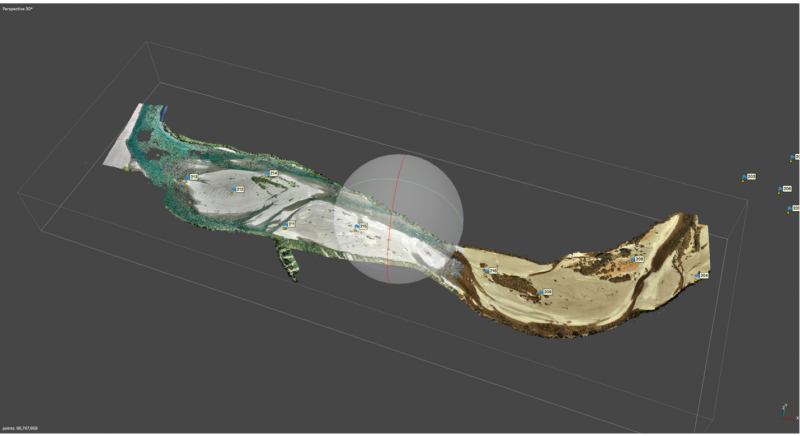
This year’s topographic survey was completed using Photogrammetry and a sUAS (aka Drone). We achieved an excellent absolute accuracy using this process along with about a dozen RTK surveyed Ground Control Points (thank you Conor Shae of the USFWS). In addition to a much more accurate survey, we also reduced costs as compared with a more traditional total station survey like we did in the past. The Estuary is ideal for drone mapping missions as the terrain is fairly flat and open. A total of nine flights at 300 feet altitude AGL (Above Ground Level).
A draft report was completed and is available for download here.
In Fall 2013 and again Fall of 2016 hundreds of whole trees were put into the estuary. Details are included in the Final Reports for those projects.
The 2016 helicopter wood placement component for this 2016 work included the following numbers of whole trees placed:
Table 2 – 2016 wood placement stats
|
Area L-1 |
12 pcs |
|
Area L-2 |
9 pcs |
|
Area R-1 |
9 pcs |
|
Area R-2 and R-3 |
31 pcs |
|
Area R-4 |
22 pcs |
|
Area R-5 |
11 pcs |
|
Woodzilla 2 |
9 pcs |
|
Total |
103 pcs |
A total of 103 pieces placed in-stream, at terrace margins, or on the right bank (nearly all were Whole-trees, with boles and integral root wads). Plus, approximately another 150 pieces were delivered to the south-side terrace — to sites L-3 and L-4, located upstream from the 2013 project area — and subsequently used for stream barbs (small to medium-sized trees, some without root wads). Trees were tipped on-slope with an excavator and placed in the river by helicopter. Total acres of riparian area treated was 20. Over 2000 15-foot long willow cuttings were planted in the deep trenched baffles.
We constructed 30 stream barbs with 160- 60 to 80-foot-long trees that were 16-36” in diameter with root wads and limbs. The total trench length was 2740 feet with 3,340 willow cuttings 15- 20 feet long and multi branched. The stream barbs treated 2010 feet of stream bank. This approach uses a bio-technical terrace margin treatment designed to increase bank resistance to erosion. The trenches were placed at about a 30-degree angle downstream with the flow and about 50-70 feet apart. The trenches were excavated 15-20 feet deep to the summer water table so that the cuttings were placed in water immediately after being cut. After backfilling the trenches, the area was regraded and mulched.
After tree placement was complete, the Mattole Salmon Group implemented a monitoring program to answer the question,” Which trees moved, under what size flows, and where.” This monitoring program involved placing a Passive Identification Tag (PIT) into each whole tree. A hole was drilled with a cordless drill at 4’ above root wad. The hole was drilled towards the center of the log, and at a depth to put the tag ½ inch under the cambium. The tag was inserted into the tree (see figure 5). Silicone calk was used to seal the hole and secure the tag. Trees with greater than 16” diameter got two tags, on opposite sides of the tree. Additional information was collected about size (total length and diameter at breast height (DBH), species and complexity for each tree and associated with the trees individual number. Using a total station all trees were marked in their orientation on the landscape.
The total station work gave us an as built map of the entire project site with one (1) foot contour intervals.
Two re-surveys have taken place since the project began. One in the spring of 2014, and another in the Spring of 2017. Re-surveys involve scanning the tree PIT tags and using GPS to locate each tree on the project map. This shows which trees have moved and to where. We used a total station to re-map terrain elevations after many significant high flows (over 25,000 CFS) during 2016-2017.
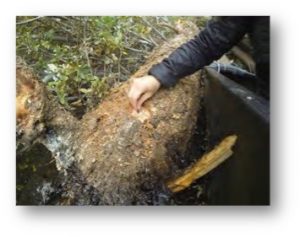
FIGURE 4 – A PASSIVE IDENTIFICATION TAG (PIT) TAG IS INSERTED INTO TREE 4’ ABOVE ROOTWAD
The 2019 large wood survey found 64 pieces of large wood.
However, the actual number is greater because there are multiple structures with multiple pieces of large wood in them, which were recorded as a single piece (eg. Woodzilla 2 structure is 9 whole-trees).
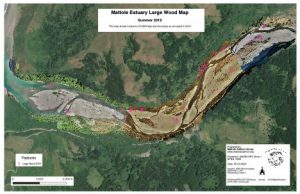
In 2012 there were 8 pools 3-5 feet deep in the treatment reach. After the placement of the 2013 and 2016 heliwood trees, and after high flows of 2016/2017, there were 20 pools that were 5-12 feet deep in the same reach. All pools were in close association with the placed heliwood.
In 2019 there were 14 pools that were 4-10 feet deep (see Figure 7) It should be noted that a more restrictive definition for pools was implemented in 2019, which if used in previous surveys would have resulted in fewer pools. One goal in 2019 was to standardize definition of pools going forward to be able to easily replicate in the future.
For our purposes, Pools are defined as a small part of the reach with reduced velocity, little surface turbulence and deeper water than surrounding areas. To be considered a pool for this survey, the maximum depth at the deepest point was a minimum of 4 feet. Additionally, pools have the following characteristics:
Table 3 – 2019 Pool Measurements
|
||||||||||||||||||||||||||||||||||||||||||||||||||||||||||||||||||||||||||||||||
Pool locations are shown in Figure 7. Full size maps are available on the file server as geo-referenced PDFs ready to print at full-resolution up to Tabloid size (11×17).
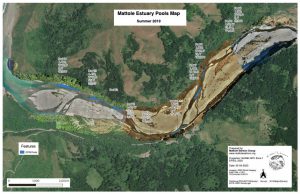
FIGURE 7 – MAP OF POOLS IN SUMMER 2019
The final map (see figure 8) shows large wood as placed as well as movement between surveys. This is a draft copy of this map and will be replaced in final version.
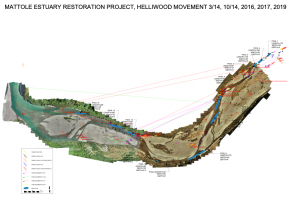
FIGURE 8 – LARGE WOOD MOVEMENT MAP
My workflow involves a multi-step process using a few different apps. Flight mission planning and image acquisition is done with Pix4D Capture using a DJI Phantom 4 Pro V2.
Post image processing and dense point cloud are created with Agisoft MetaShape Pro. Final maps are produced using QGIS on a Mac.
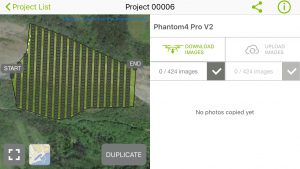
Sample Flight Mission Plan in Pix4D Capture
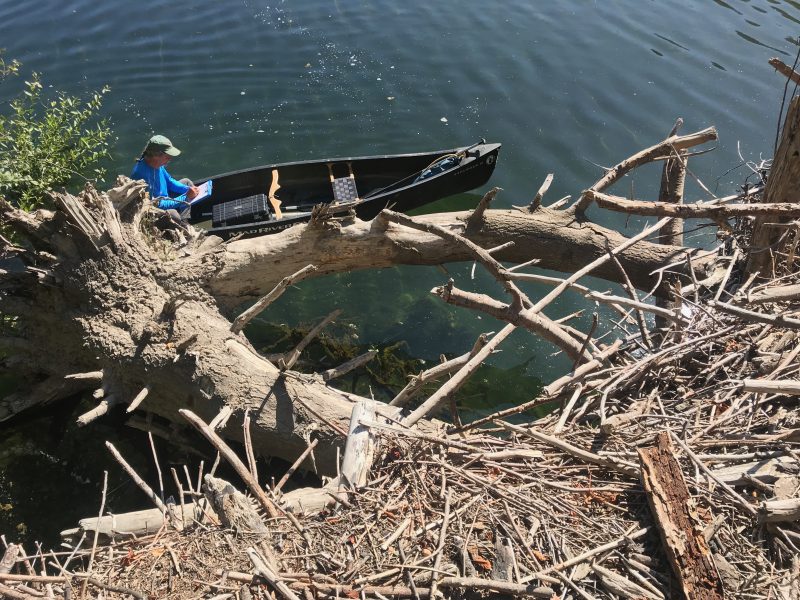
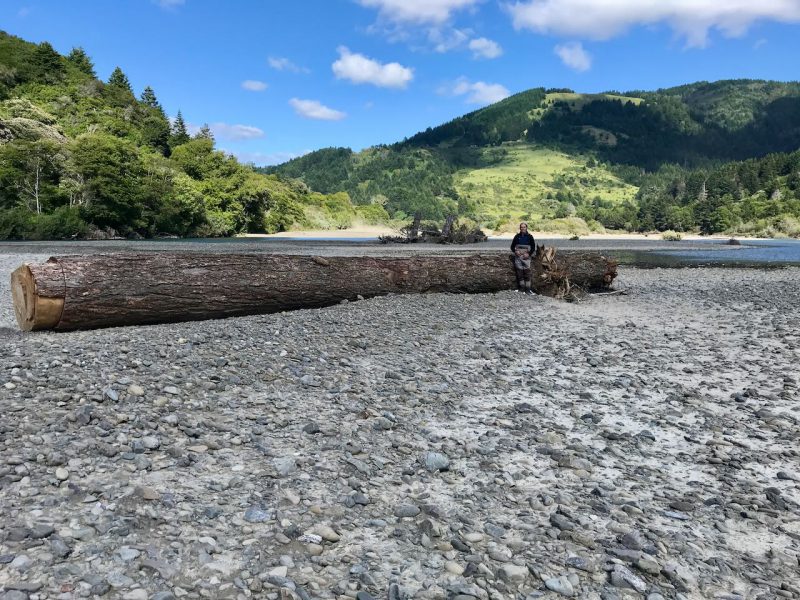
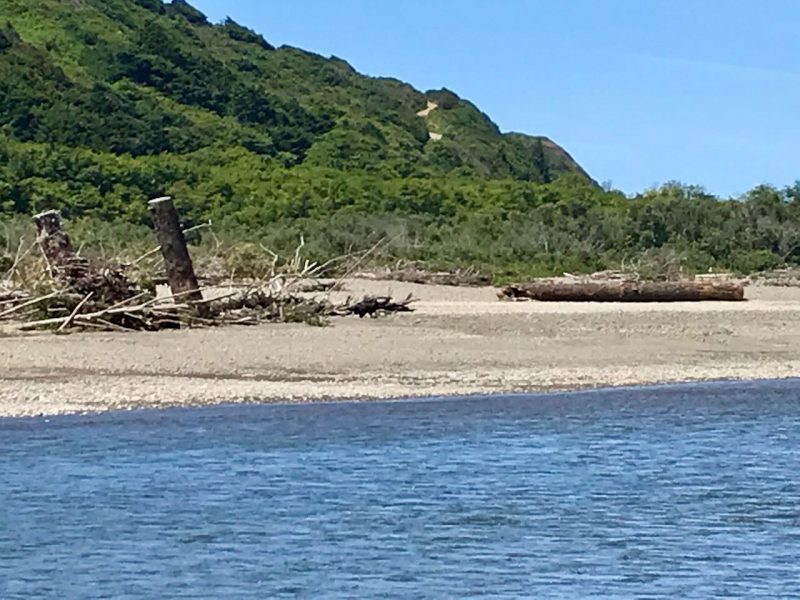
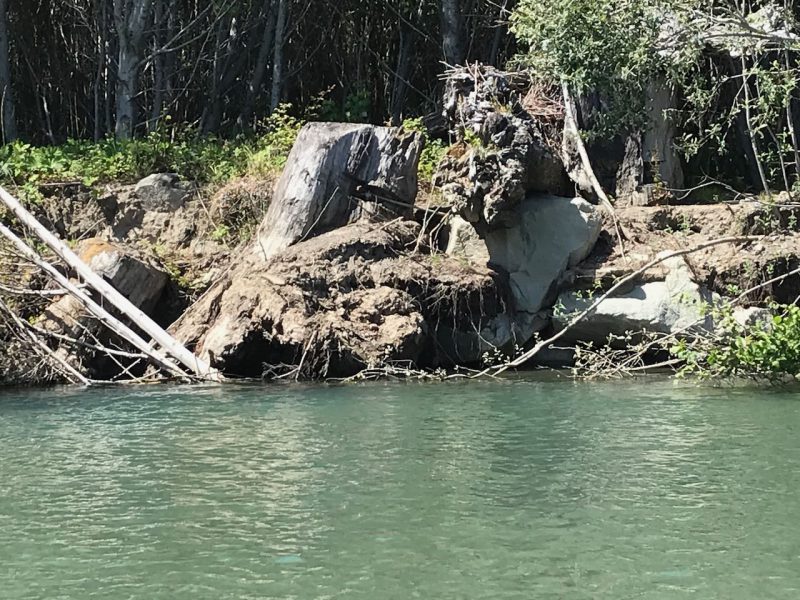

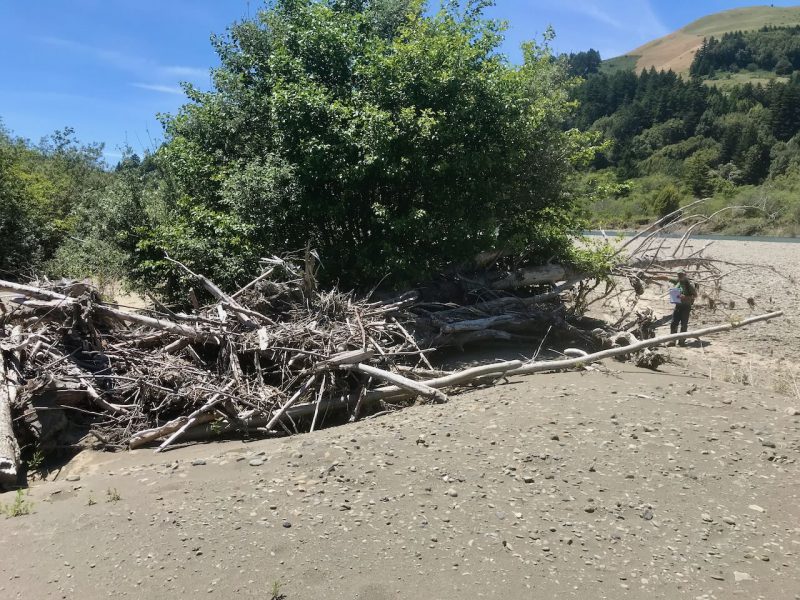
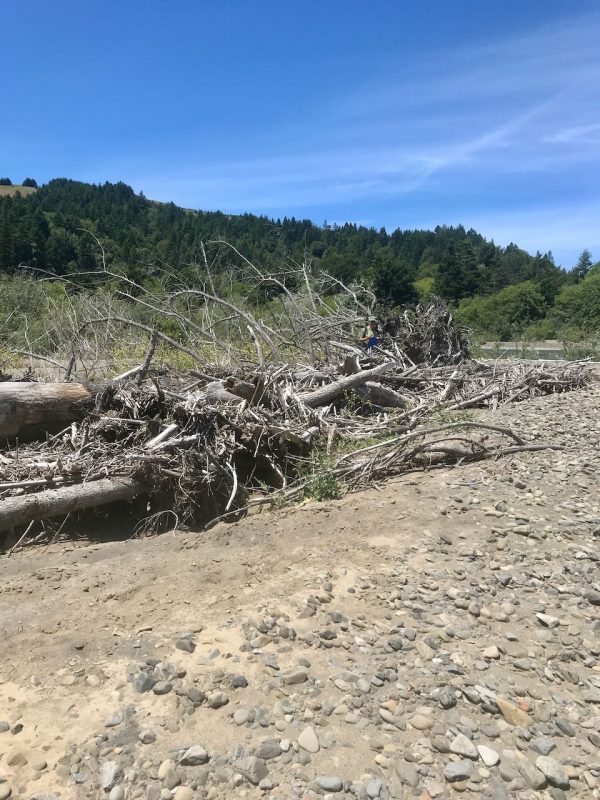
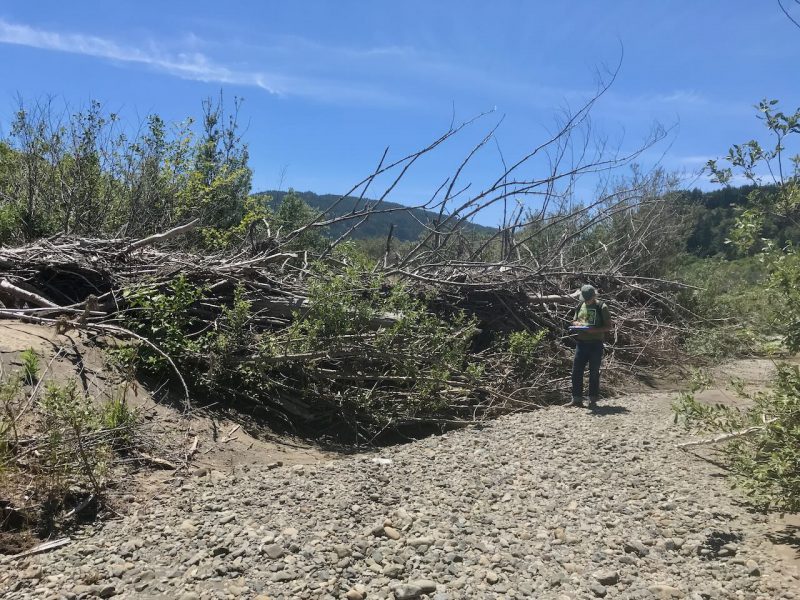
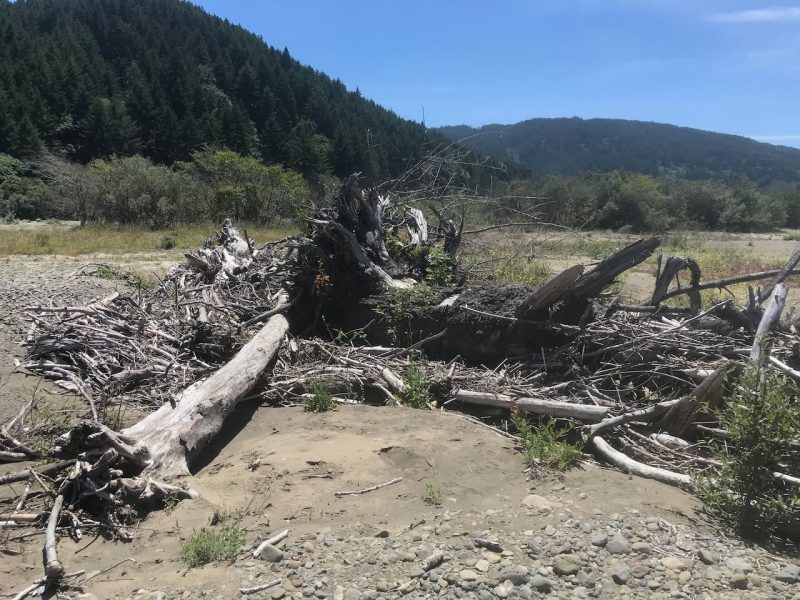
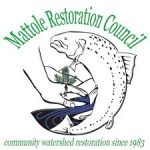
The Mattole Restoration Council is a 36 year-old watershed restoration non-profit on the Lost Coast of Northern California, with a million dollar plus annual budget and a regular staff of nine. We are a membership organization with an elected board of directors that undertakes landscape-scale watershed restoration and rehabilitation in the Mattole watershed and adjacent areas, and promotes a stewardship land ethic. For more information about our programs, please visit www.mattole.org.
Job responsibilities
Desired Qualifications
The position is full to half time (negotiable), and reports to the board of directors. Compensation is commensurate with experience, and includes health, vacation, training and retirement benefits. The position is based in the Petrolia office, with travel throughout the watershed and Northern California. A valid driver’s license and functioning personal vehicle are required.
To Apply: Email cover letter, resume/CV and three references to John Williams, jgwill@frontiernet.net. For more information, call John at 707 629 3265.
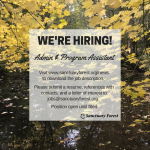
Sanctuary Forest seeks a highly organized, detail-oriented and experienced individual to assist with office and program duties. This position is based at our office in Whitethorn, about 30 minutes west of Garberville.
This position is 20 hours per week, 3-4 days per week. Pay rate based on skill level and experience. Sick leave, holiday pay and vacation provided.
Please submit cover letter and resume, with references, to jobs@sanctuaryforest.org—put job title in the subject line. For more information, send inquiries to the above email address, or call (707) 986-1087 ext. 1#.
Position open until filled.
For a complete job description, click here.

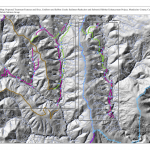
Funded by: the CDFW and Lost Coast Forestlands
The Mattole Salmon Group, in collaboration with participating landowners, heavy equipment contractor McCullough Construction, the CDFW, Pacific Watershed Associates and Lost Coast Forestlands, recently completed a project designed to reduce sediment delivery and improve salmonid habitat in Coulborn and Sebbas Creeks, located in the Middle South Fork Eel watershed, approximately 7 miles upstream of the confluence of Indian Creek and South Fork Eel River.
The objective of the project is to reduce sediment delivery and improve water quality for all life stages of salmonids in Indian Creek by preventing the delivery of approximately 5,129 yd3 of sediment from road-related sediment delivery features to Coulborn and Sebbas Creeks including, upgrading 17 features on 1.9 miles of road and decommissioning 38 features on 3.5 miles of road (a total of 55 features on 5.4 miles of road).
Completion of the project included installing culverts at stream crossings, planting trees along stream channels, applying straw mulch and rock to control erosion, and spreading native grass seed to re-plant bare earth surfaces.
Anecdotal information provided by Scott Downie (CDFW, retired), local foresters with historical knowledge, and several sources of unpublished literature, indicate that instream habitat in the Indian Creek tributaries became degraded primarily in the 1950s to 1980s as a result of unrestricted logging, tractor yarding, and road construction practices. Many of the Indian Creek watershed tributaries were filled with logging debris and sediment, and were used as skid trails and railroad routes during the first and second cycles of logging, the remnants of which can still be observed today. In the 1970s these watersheds were further subjected to stream clearing, which resulted in the removal of significant volumes of Large Woody Debris (LWD). The legacy effect of all of these deleterious activities is clearly identified in each stream inventory report and is manifested as chronic fine sediment delivery from the road system, episodic catastrophic failure of stream crossings, a diminished pool frequency and cover, significant bank erosion along stream channels, locally dysfunctional or poorly functioning riparian habitat, and high values of substrate embeddedness.
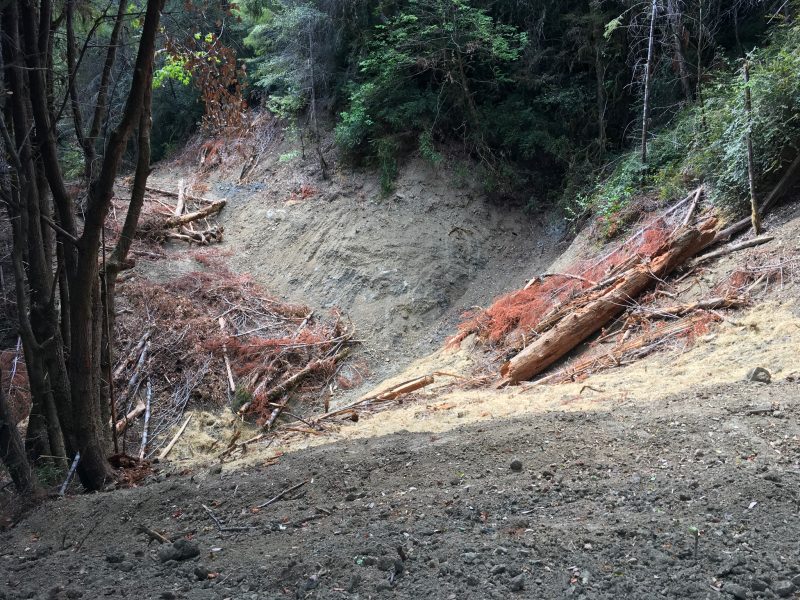
Heavy equipment and labor subcontractor, McCullough Construction, a highly skilled and well qualified heavy equipment contractor, provided all the necessary heavy equipment, experienced operators, and skilled laborers required to complete the project as designed. This included but may not be limited to the excavation of stream crossing fills, unstable road fills, road drainage treatments, and installation of instream structures using a team of hydraulic excavators, bulldozers, and dump trucks. In addition, laborers were used to spread straw and mulch, man and monitor pumps during necessary dewatering operations, maintain and monitor equipment, and work on in-stream habitat improvement structures. Laborers will also conduct tree planting this winter as the final phase of implementation.
